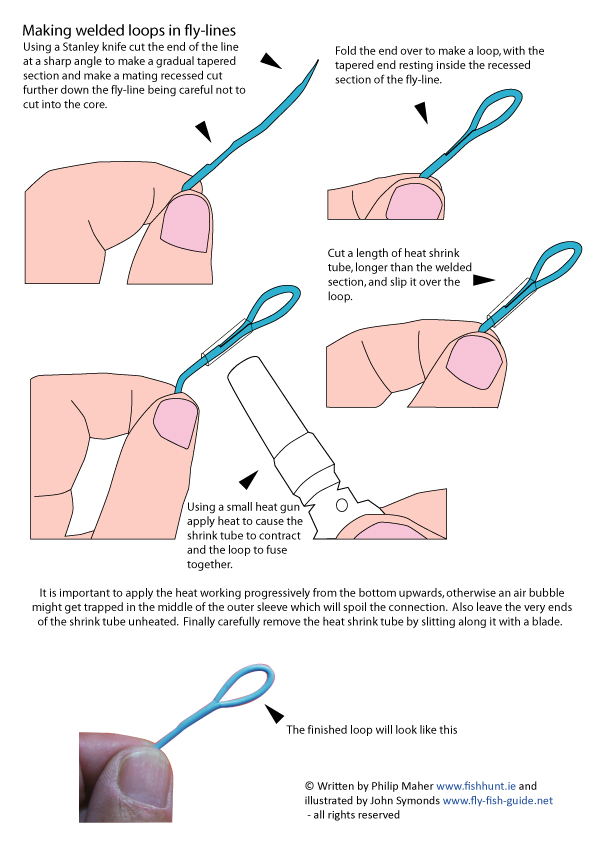Fly Line and Rod ratings
A fly-rod can be considered to be a spring with a selected stiffness. The amount of stiffness is calculated by the fly-rod manufacturer and all manufacturers design to the same stiffness scale so that in theory all fly-lines and fly-rods are balanced and interchangeable. The scale most widely adopted is called the AFFTA (American Fly Fishing Trade Association) rating, which is given in the table below. The AFFTA ratings are based on the weight of the front 30 feet section of the fly-line, excluding any level section of line-tip.
| AFFTA Number | Line Weight | Tippet Strength (lbs) | Size of fly | ||
| grains | grams | ounces | |||
| 1 | 60 ± 6 | 3.9 | 0.14 | 4 | 12 - 20 |
| 2 | 80 ± 6 | 5.2 | 0.18 | ||
| 3 | 100 ± 6 | 6.5 | 0.23 | ||
| 4 | 120 ± 6 | 7.8 | 0.27 | ||
| 5 | 140 ± 6 | 9.1 | 0.32 | 6 | 10 - 16 |
| 6 | 160 ± 8 | 10.4 | 0.37 | 6 - 8 | 8 - 14 |
| 7 | 185 ± 8 | 12 | 0.42 | ||
| 8 | 210 ± 8 | 13.6 | 0.48 | 8 | Leaded lures |
| 9 | 240 ± 10 | 15.55 | 0.55 | 10 | Heavy tubes |
| 10 | 280 ± 10 | 18.15 | 0.64 | 10 - 15 | |
| 11 | 330 ± 12 | 21.4 | 0.75 | 12 - 20 | |
| 12 | 380 ± 12 | 24.6 | 0.86 | ||
| 13 | 450 ± 15 | 29.2 | 1.03 | ||
| 14 | 500 ± 15 | 32.4 | 1.14 | ||
| 15 | 550 ± 15 | 35.6 | 1.26 | ||
Fly-lines for two-handed fly-rods use a different rating scale and there are four categories which are based on head length.
| AFFTA Number | <50 ft long | 50 - 60ft long at 55ft |
60 - 70ft long at 65ft |
Over 70ft long at 80ft |
||||
| Shooting head | Short belly | Mid belly | Long belly | |||||
| grains | grams | grains | grams | grains | grams | grains | grams | |
| 5 | 210 | 13.6 | 380 | 24.6 | 420 | 27.2 | 560 | 36.3 |
| 6 | 250 | 16.2 | 420 | 27.3 | 460 | 29.9 | 600 | 39 |
| 7 | 300 | 19.5 | 470 | 30.5 | 510 | 33.1 | 650 | 42.2 |
| 8 | 360 | 23.4 | 530 | 34.4 | 570 | 37 | 710 | 46.1 |
| 9 | 430 | 27.9 | 600 | 39 | 640 | 41.6 | 780 | 50.6 |
| 10 | 510 | 33.1 | 680 | 44.2 | 720 | 46.8 | 860 | 55.8 |
| 11 | 600 | 39 | 770 | 50 | 810 | 52.6 | 950 | 61.7 |
| 12 | 700 | 45.5 | 870 | 56.5 | 910 | 59.1 | 1050 | 68.2 |
There is also another rating scale for Skagit lines. These are lines that have a long, buoyant , body designed to make it easy to turn over an interchangeable heavier tip, which can be helpful for fishing in situations where there are space restrictions.
| AFFTA # | grains | grams |
| 5 | 400 | 25.9 |
| 6 | 450 | 29.16 |
| 7 | 550 | 35.64 |
| 8 | 600 | 38.88 |
| 9 | 650 | 42.12 |
| 10 | 750 | 48.6 |
Fly-line characteristics

Fly-line types
Choice of fly-line depends upon the size of fly, fishing depth, speed of current, casting space, water temperature, prevailing wind strength and casting distance but most casters are concerned with creating tight loops, which reduce wind resistance and give good turnover.
When the fly-line has been cast then how it behaves in the water has to be considered. For example to avoid skating the fly along the water’s surface it is common practice to attach an intermediate tip to the fly-line or sometimes the fish can be way below the water’s surface and so a sinking line is the best way of reaching them. There is a wide selection of speciality lines available for all conditions and styles of fishing, however, for versatility, multi-tip lines have been developed or there is a range of shooting-heads which are loop to loop connected to a running line for a quick change over, thus it is not necessary for the modern angler to carry lots of reels or spools.
The most widely used type of fly-line is probably the weight forward floater, which gives the best combination of turnover and distance and it is relatively easy to roll cast. However, many modern fishers are using shooting heads because these give greater versatility and can be used more effectively in confined casting spaces for instance where there is a high river bank, trees or undergrowth which will inhibit a back-cast. These lines are relatively short, are available in a variety of densities from floating to fast-sinking and everything in between, including density combinations such as an intermediate/sink line. There is also a modern trend to use a heavy bodied line with relatively short poly-tips, thus widening the fishing options available to the angler, whilst being extremely compact and portable.
Making connection loops

